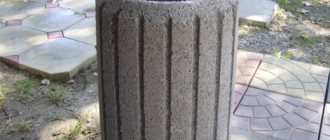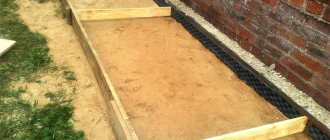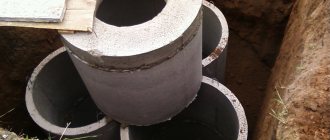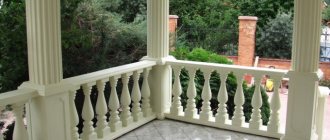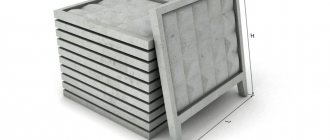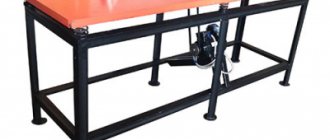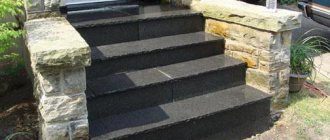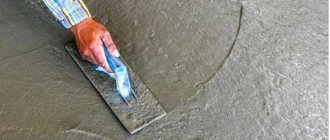Hi all! Now the time has come when we spend it at the dacha planting, weeding, and other garden chores. But in the meantime, you need to sit down to relax, admire the results of your work while drinking aromatic tea, right? So today we’ll make a bench, and not just a simple one, but a monolithic, shaped one. Why not wood or metal? We will have a bench outside, in the rain and snow, but the wood rots, the metal rusts, and it needs to be repainted periodically. And concrete lasts forever . In addition, such a bench will not be stolen, and if desired, it can also be beautifully decorated with natural stone, tiles, and mosaics. Agree, a bench lined with stone or mosaic will also fit perfectly into the natural landscape design of the garden. Well, let's go, let's look at a specific example from the first person.
This was my first project of concreting a monolithic bench; before that I had only poured fence posts. Having the necessary tools, I decided to pour a monolithic bench made of concrete, since it has many advantages, unlike a wooden one (described above), and besides, I can give the bench top any shape I want by pouring concrete into a pre-prepared matrix (mold).
Photo 1. Durable homemade concrete bench - for centuries
On a note:
Garden bench from the ZhBI-4 plant
The garden bench is manufactured according to all the rules not only for the production of reinforced concrete products, but also taking into account ergonomics.
Both garden benches and garden benches are made with a wooden seat, for which coniferous wood is used. All wooden elements of a bench or bench are treated with fire-retardant materials and bioprotective compounds. This allows you to significantly increase the service life of the wooden seat. Considering the durability of reinforced concrete supports, this indicator is very important.
To enhance the appearance of the bench, both the wooden seat and concrete supports can be painted. Wood is factory-coated with a special varnish, and concrete legs can be painted during use. Wooden crossbars and beams are attached to the concrete base of the bench with special bolts.
Concrete benches - general characteristics
The bench located in the recreation area combines decorative and utilitarian functions. Traditionally, the product is equipped with seats and backs made of wood , which makes it as comfortable as possible. The form can be very diverse.
Such small architectural forms are environmentally friendly, resistant to temperature and humidity fluctuations, durable and require minimal maintenance. The characteristics of artificial stone make it possible to create original benches that imitate the textures and colors of many natural materials.
If periodic treatment is carried out with special compounds with water-repellent properties, the product will be used for several decades without loss of appearance . Concrete park benches are indispensable in the country house and garden.
If the bench will be outdoors all year round, at the concrete mixing stage it is recommended to add additives to the mixture to increase its frost resistance and strength.
Benches with concrete legs: tips for making your own
Bench on concrete legs
In parks and squares, in squares and along pedestrian paths, in playgrounds and cottages, benches are installed that allow people to relax, spend time in the fresh air, enjoy nature, chat with friends, or just read a book. Among the variety of models available, benches with concrete legs occupy their niche and enjoy deserved popularity.
What are the types of benches on concrete supports?
Benches made from various materials are used for outdoor installation: metal, stone, wood, concrete. Combinations are most often used, for example, the seat and back of the bench are made of wood, and the legs are made of metal or concrete.
Benches not only provide an opportunity to have a pleasant time outside, but also serve as an element of landscape design and decoration of the exterior of buildings. Small architectural forms, which include benches, can be made using various style solutions, be simple, strict or beautifully decorated.
What qualities should a street bench have:
- Durability.
- Strength.
- Sustainability.
- Ergonomics.
- Convenience for vacationers. The dimensions and shape of the benches should allow people to have a good time.
- Immune to climatic factors. Since the structure is usually installed outdoors, it must be impervious to sunlight, wind and precipitation. For this purpose, materials are used that do not themselves respond to the vagaries of the weather - or they are treated with special protective compounds.
- Environmentally friendly.
- Anti-vandal properties are also important when installed in public areas.
Bench elements made of concrete have all these characteristics. In addition, due to the plasticity of the material, structures of any shape and size can be made from it. Most often, bench legs are made from concrete.
Important! It is recommended to cover the concrete elements of benches located on the street with water-repellent compounds.
You won’t get any pleasure from sitting on a concrete base, so most often wood or WPC is used for finishing.
Concrete park benches with wood trim
Where benches on concrete supports can be installed:
- Near children's playgrounds.
- Near shopping complexes, public institutions.
- On boulevards, streets, squares.
- On the territory of garden and park ensembles.
- In private country estates.
An outdoor bench may have a backrest, or consist only of a seat and supports.
Concrete bench without back Concrete garden bench with back
The shapes of benches can be very diverse, sometimes strange.
For installation in places for various purposes, you can select models that fit best into the surrounding space.
To decorate a patio or, for example, an area near a pool, this complex design is perfect:
Bench on semicircular supports
For the territory of public institutions, a similar model with built-in flower beds is quite appropriate:
Outdoor concrete benches with flowerpots
Near entrances and in parks you can spend time sitting on simple but stylish benches:
Concrete park benches
It's no secret that street benches are often of interest to those who like to take what's lying around - in other words, to thieves. Difficulties will certainly arise with the removal of such massive benches, since their weight can reach up to 300-500 kg. This is why concrete benches are so popular in public places.
Massive reinforced concrete benches
Concrete itself doesn't look very attractive. When making concrete elements, pigments can be added to the mixture for coloring. And the use of mineral chips allows you to obtain an interesting texture of products.
There are a large number of design options on the market. When choosing a model, it is important to determine the required parameters: dimensions of the seat and supports, backrest height.
There are several options for installing benches. They depend on the shape and weight of the supports, the characteristics of the surface on which the benches will be installed, and the likelihood of theft.
- Most often, the bench is simply installed on a solid, level base.
- If you plan to place the bench on the ground, holes about 10 cm deep are dug in it.
- The recess is carefully compacted, then gravel is added in a layer of 7-8 cm. After compacting it, you can place a bench on the arranged base.
- Occasionally, to prevent theft of structures, concreting or anchoring is carried out.
Making benches with concrete legs
All kinds of bench options included, and separate concrete legs, can be purchased ready-made, or ordered in a workshop. However, bench elements are not so difficult to make with your own hands. Forms for concrete benches made of fiberglass or ABS plastic are available for sale.
Forms for concrete benches
However, even without them, you can easily cast the necessary elements, or use standard products. Let's look at how to make a concrete bench with your own hands.
Bench with concrete legs
Brief instructions for making a bench on concrete supports:
- For work you will need: concrete mixture, boards, plywood, MDF or chipboard for forms, boards or bars for sitting.
- To cast the necessary supports, formwork must be constructed. These will be the forms for making concrete benches. It is better to coat the surface of the wood that will be inside with machine oil (or vegetable oil) to make dismantling the molds easier later. Two identical boxes are knocked together.
Formwork for concrete legs
- Blocks should be placed at the bottom of the molds, which will form recesses in the concrete legs for installing boards.
- The concrete mixture is diluted.
- You need to fill the form with small parts of the mixture, compacting it thoroughly. By tapping the sides of the mold with a hammer, you can remove excess air bubbles.
- Use a spatula to level the top (it will later become the bottom of the supports).
- After 3-4 days, the formwork is dismantled.
- Prepared boards are installed in the left recesses.
- The bench is ready.
An all-concrete bench can be cast in a similar way.
Important! When making the entire bench from concrete, you may have to use reinforcement.
If this topic interests you, you can watch the video in this article in which a concrete bench is made.
Concrete slab bench
The legs of the bench can also be made from concrete slabs mounted on an edge. Pre-treated boards are attached between the slabs using threaded rods.
Concrete block bench
Another simple, but quite nice option is a bench made of concrete blocks. Anyone can make such a design (see photo).
Concrete block bench
The blocks are connected to each other using glue and painted in the desired color. The beams are sanded, treated with stain and varnish and the bench is ready.
When decorating public places and private areas, benches made of concrete and wood are most often used to organize outdoor recreation and decorate the space. For personal use, anyone can make a structure on concrete legs.
beton-house.com
DIY garden benches from scrap materials
Bench made from pallets
When making a garden bench, you can show your imagination and make it from scrap materials. Here are some examples:
- Street shop made from pallets. You will need three or four pallets, which are fastened together with self-tapping screws to form seats. On the sides they are connected by corners made of wooden blocks or planks. After construction, the pallets must be carefully sanded and painted.
- A bench installed between the trees. In this case, two trees serve as its supports - legs.
- Wooden bench made from old chairs. In this case, there are several options for how to make a bench out of them. One of them is that two, three or more chairs without seats are fastened together in one row, and a crossbar is placed on them. Another option is to leave the back of two chairs with the back and legs. They are turned towards each other, connecting with timber on four sides. For greater strength, another timber frame is attached below, 20 cm from the floor. After this, the wood is sanded and coated with paint. The seat is made of thick plywood, upholstered with foam rubber and covered with fabric.
- Benches made from leftover wood fuel: slabs, lumps, untreated edged boards look original and distinctive. If you have an old but large-diameter log of suitable length, you can make a simple bench: cut a piece of wood at an angle that makes up a seat with a backrest, and then attach the legs to it.
- If you have two old but strong wooden boxes, you can invent a bench: attach a crossbar made of several boards knocked together between them. Fill the boxes with soil and plant flowers in them. You will get an original garden bench with flower beds. Instead of boxes, you can use concrete flower beds.
- Crossbars inserted through the cells of hollow concrete blocks form an excellent bench.
- Stone bench: a large pile of cobblestones, pebbles, and other stones is collected and placed inside a thick wire mesh. Such structures are called gabions; they are often used to construct low barriers in areas. A wooden seat covered with foam rubber is placed on top, or you can put regular seat cushions.
It is pleasant to relax on benches made from scrap materials, marveling at how close the material is suitable for constructing such objects.
